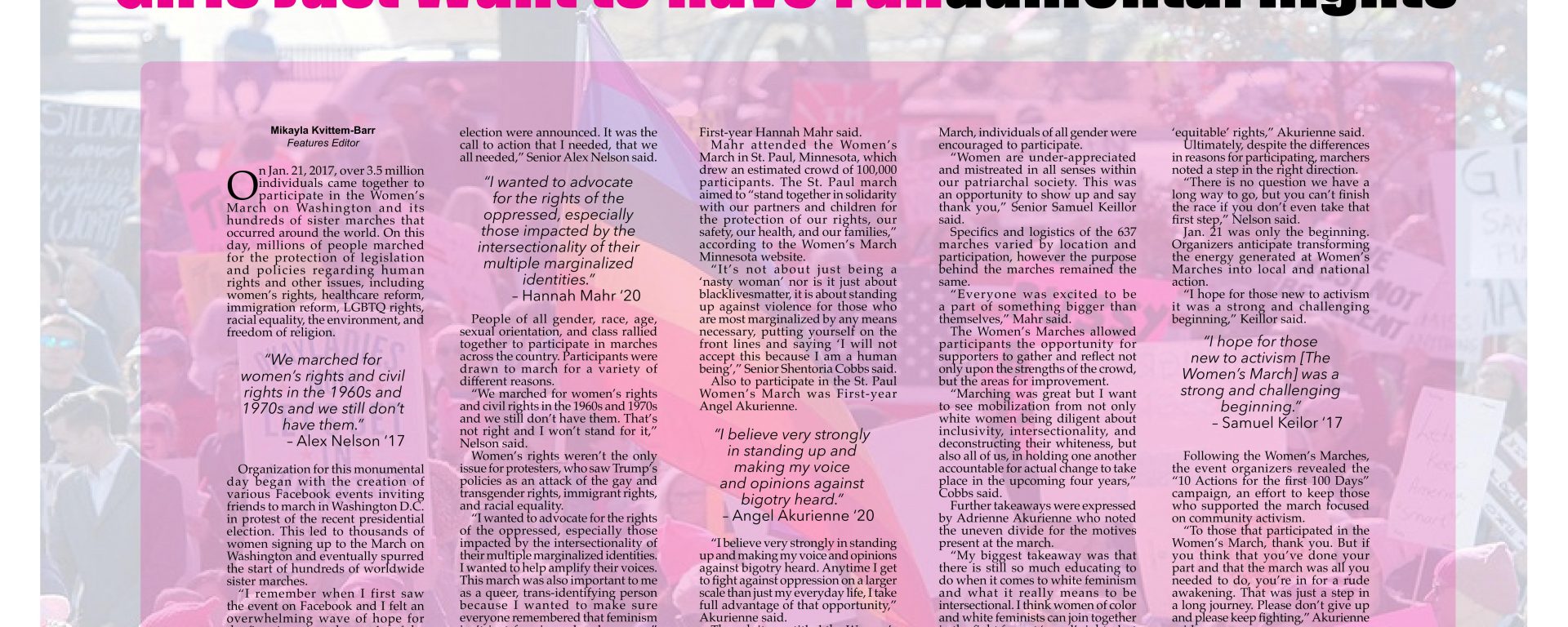On Jan. 21, 2017, over 3.5 million individuals came together to participate in the Women’s March on Washington and its hundreds of sister marches that occurred around the world. On this day, millions of people marched for the protection of legislation and policies regarding human rights and other issues, including women’s rights, healthcare reform, immigration reform, LGBTQ rights, racial equality, the environment, and freedom of religion.
“We marched for women’s rights and civil rights in the 1960s and 1970s and we still don’t have them.” – Alex Nelson ‘17
Organization for this monumental day began with the creation of various Facebook events inviting friends to march in Washington D.C. in protest of the recent presidential election. This led to thousands of women signing up to the March on Washington and eventually spurred the start of hundreds of worldwide sister marches.
“I remember when I first saw the event on Facebook and I felt an overwhelming wave of hope for the first time since the results of the election were announced. It was the call to action that I needed, that we all needed,” Senior Alex Nelson said.
“I wanted to advocate for the rights of the oppressed, especially those impacted by the intersectionality of their multiple marginalized identities.” – Hannah Mahr ‘20
People of all gender, race, age, sexual orientation, and class rallied together to participate in marches across the country. Participants were drawn to march for a variety of different reasons.
“We marched for women’s rights and civil rights in the 1960s and 1970s and we still don’t have them. That’s not right and I won’t stand for it,” Nelson said.
Women’s rights weren’t the only issue for protesters, who saw Trump’s policies as an attack of the gay and transgender rights, immigrant rights, and racial equality.
“I wanted to advocate for the rights of the oppressed, especially those impacted by the intersectionality of their multiple marginalized identities. I wanted to help amplify their voices. This march was also important to me as a queer, trans-identifying person because I wanted to make sure everyone remembered that feminism isn’t just for cisgendered women,” First-year Hannah Mahr said.
Mahr attended the Women’s March in St. Paul, Minnesota, which drew an estimated crowd of 100,000 participants. The St. Paul march aimed to “stand together in solidarity with our partners and children for the protection of our rights, our safety, our health, and our families,” according to the Women’s March Minnesota website.
“It’s not about just being a ‘nasty woman’ nor is it just about blacklivesmatter, it is about standing up against violence for those who are most marginalized by any means necessary, putting yourself on the front lines and saying ‘I will not accept this because I am a human being’,” Senior Shentoria Cobbs said.
Also to participate in the St. Paul Women’s March was First-year Angel Akurienne.
“I believe very strongly in standing up and making my voice and opinions against bigotry heard.” – Angel Akurienne ‘20
“I believe very strongly in standing up and making my voice and opinions against bigotry heard. Anytime I get to fight against oppression on a larger scale than just my everyday life, I take full advantage of that opportunity,” Akurienne said.
Though it was titled the Women’s March, individuals of all gender were encouraged to participate.
“Women are under-appreciated and mistreated in all senses within our patriarchal society. This was an opportunity to show up and say thank you,” Senior Samuel Keillor said.
Specifics and logistics of the 637 marches varied by location and participation, however the purpose behind the marches remained the same.
“Everyone was excited to be a part of something bigger than themselves,” Mahr said.
The Women’s Marches allowed participants the opportunity for supporters to gather and reflect not only upon the strengths of the crowd, but the areas for improvement.
“Marching was great but I want to see mobilization from not only white women being diligent about inclusivity, intersectionality, and deconstructing their whiteness, but also all of us, in holding one another accountable for actual change to take place in the upcoming four years,” Cobbs said.
Further takeaways were expressed by Adrienne Akurienne who noted the uneven divide for the motives present at the march.
“My biggest takeaway was that there is still so much educating to do when it comes to white feminism and what it really means to be intersectional. I think women of color and white feminists can join together in the fight for not ‘equal’ rights, but ‘equitable’ rights,” Akurienne said.
Ultimately, despite the differences in reasons for participating, marchers noted a step in the right direction.
“There is no question we have a long way to go, but you can’t finish the race if you don’t even take that first step,” Nelson said.
Jan. 21 was only the beginning. Organizers anticipate transforming the energy generated at Women’s Marches into local and national action.
“I hope for those new to activism it was a strong and challenging beginning,” Keillor said.
“I hope for those new to activism [The Women’s March] was a strong and challenging beginning.” – Samuel Keilor ‘17
Following the Women’s Marches, the event organizers revealed the “10 Actions for the first 100 Days” campaign, an effort to keep those who supported the march focused on community activism.
“To those that participated in the Women’s March, thank you. But if you think that you’ve done your part and that the march was all you needed to do, you’re in for a rude awakening. That was just a step in a long journey. Please don’t give up and please keep fighting,” Akurienne said.
